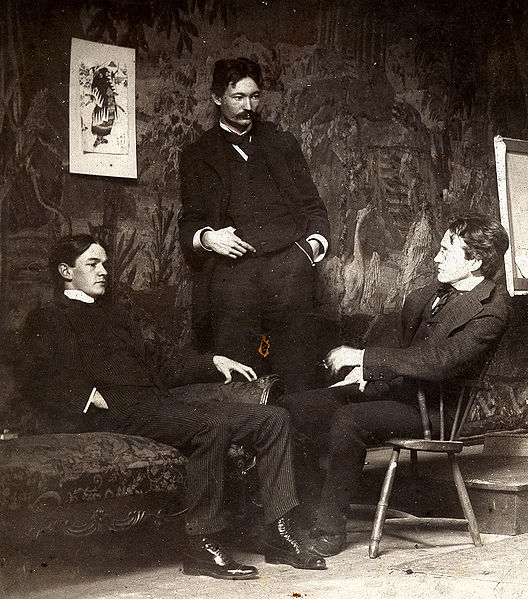The Ashcan School, also called the Ash Can School, was an artistic movement in the United States during the late 19th-early 20th century that produced works portraying scenes of daily life in New York, often in the city's poorer neighborhoods.
John French Sloan, Self-portrait, 1890, oil on window shade, 14 × 11+7⁄8 inches, Delaware Art Museum, gift of Helen Farr Sloan, 1970. John Sloan was a leading member of the Ashcan School.
Ashcan School artists and friends at John French Sloan's Philadelphia Studio, 1898
Ashcan School artists, c. 1896, left to right, Everett Shinn, Robert Henri, John French Sloan
Thomas Pollock Anshutz, The Farmer and His Son at Harvesting, 1879. Five members of the Ashcan School studied with him, but went on to create quite different styles.
An art movement is a tendency or style in art with a specific art philosophy or goal, followed by a group of artists during a specific period of time, or, at least, with the heyday of the movement defined within a number of years. Art movements were especially important in modern art, when each consecutive movement was considered a new avant-garde movement. Western art had been, from the Renaissance up to the middle of the 19th century, underpinned by the logic of perspective and an attempt to reproduce an illusion of visible reality. By the end of the 19th century many artists felt a need to create a new style which would encompass the fundamental changes taking place in technology, science and philosophy.
Jacques-Louis David, The Coronation of Napoleon, (1806), Musée du Louvre, Neoclassicism
Eugène Delacroix, Liberty Leading the People 1830, Romanticism
Thomas Cole, The Course of Empire: The Savage State, 1836, Hudson River School
Gustave Courbet, Stone-Breakers, 1849, Realist School








